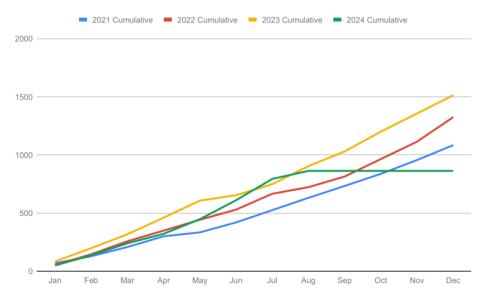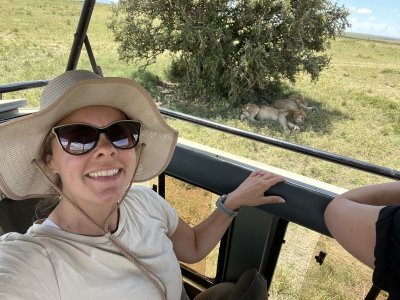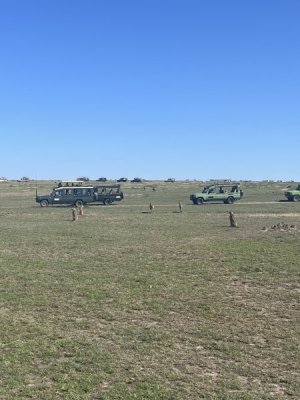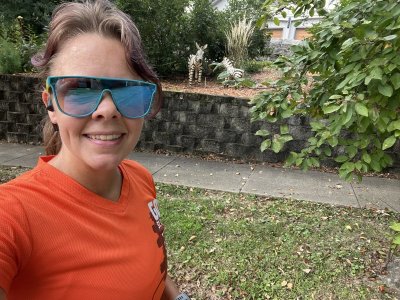You are using an out of date browser. It may not display this or other websites correctly.
You should upgrade or use an alternative browser.
You should upgrade or use an alternative browser.
Running Renaissance: One Skip Ahead of my Doom
- Thread starter GollyGadget
- Start date
LorrieAnn5
Mouseketeer
- Joined
- Aug 18, 2014
- Messages
- 381
You crushed that marathon! Congratulations! Don't ever stop telling people you ran a marathon at the Olympics. Shout it from the rooftops. You're awesome.
Thank you so much for your training journal and race report. It was a pleasure to follow along.
Thank you so much for your training journal and race report. It was a pleasure to follow along.
col1
Mouseketeer
- Joined
- Jun 9, 2010
- Messages
- 343
Congratulations , 2nd fastest marathon with those hills and heat and late time of day is awesomeCongratulations!!! Such an amazing experience and you rocked it!
Looked like an amazing trip!
nancipants
DIS Veteran
- Joined
- Nov 18, 2013
- Messages
- 4,019
Congrats! What an amazing experience! That medal design is so cool.
Love the picture of the women's marathon leaders - Sifan Hassan is just amazing!
Love the picture of the women's marathon leaders - Sifan Hassan is just amazing!
DopeyBadger
Imagathoner
- Joined
- Oct 15, 2015
- Messages
- 10,346
Incredible! You did so well with your training and it really paid off on a challenging course with challenging conditions. To negative split it is impressive! Thanks for sharing.
GollyGadget
DIS Veteran
- Joined
- Feb 15, 2017
- Messages
- 2,134
I’ve been waiting not so patiently for your trip/race report!
Thank you! Hopefully it was worth the waitWell done! You did the hard work and it paid off, so happy for your success. When we watched the men’s marathon on tv my jaw was hanging looking at those hills but you crushed them!
What an amazing experience.
Thanks!Congrats! What a unique experience!
Double thanks!Congratulations on your race! and thanks for a great trip report!!
The US broadcasters described that hill as a roller coaster incline and it's the perfect description! (I know this because of course I watched the coverage when I got home well after I experienced it in person and knew the resultsCongrats! Thanks for sharing your experience. That light tunnel on the mega hill looks like the start of a roller coaster incline. What a run!
TYSM!Congratulations!!! Such an amazing experience and you rocked it!
Merci beaucoup! I really wish I had your bilingual skills. The amount of times that people spoke to me in French and I just froze in confusion is innumerable. Of course I could have told them je ne comprends pas, but my brain was not that quick.Félicitations!
Thank you!Great job!! That’s such an awesome experience!
Luckily no one is tired of me telling them yetYou crushed that marathon! Congratulations! Don't ever stop telling people you ran a marathon at the Olympics. Shout it from the rooftops. You're awesome.
Thank you so much for your training journal and race report. It was a pleasure to follow along.
Thank you! I'm very pleased with how it all went down (and upCongratulations , 2nd fastest marathon with those hills and heat and late time of day is awesome
Looked like an amazing trip!
Thank you! DLP was a fabulous way to end an unforgettable trip. Even though it was my first time, just being at Disney filled me with joy & nostalgia. The castle park is very similar to the US counterparts but enough different that it was still fun to experience. The studios is very similar to HS. It could definitely use a few more rides but all the shows were very well done and they did an amazing job mixing English & French. I would guess that 2/3rds if the guests were from the UK so the English was much more abundant than Paris proper.Thanks for the great race report and the pictures!! It looked like so much fun (for a marathon). Bravo!!
How was DLP?
I'm still in awe of Hassan. Seriously incredible and her interviews just make me like her more.Congrats! What an amazing experience! That medal design is so cool.
Love the picture of the women's marathon leaders - Sifan Hassan is just amazing!
Thank you! It was fun to relive the race while I typed it out.Congrats and thanks for the race report (i knew you would do it but i was so excited to get to read it). Been looking forward to it.
From the bottom of my heart, many many thanks. I really was not sure how I would prepare for those hills but you managed to devise a plan that prepared me very well.Incredible! You did so well with your training and it really paid off on a challenging course with challenging conditions. To negative split it is impressive! Thanks for sharing.
Thanks! I hope they are all this good!! I was terrified of those hills so definitely took the first half easy. I'm sure it would have been a very different story if I had decided to push it.Wow. You had such a great race in so many ways. All marathons should be this good. Congrats!
GollyGadget
DIS Veteran
- Joined
- Feb 15, 2017
- Messages
- 2,134
Hey y'all, training for the WDW marathon starts soon so thought I'd pop in with a little update. I took two full weeks off after the marathon pour tous. That is pretty much standard practice for me but my personal schedule had me considering doing one week off, one week on, one more week off. I decided to go with the full two weeks in a row just to make sure my body would be nice and recovered before jumping into training again. This will be my first time training for a marathon immediately after a marathon training block. Usually I only run one marathon a year and focus on shorter stuff in between. 

 My body can handle the two training blocks back to back.
My body can handle the two training blocks back to back.
After running the most July miles ever and finally eclipsing my 2023 numbers, my mileage really dropped in August with the taper and two week rest. I'm still very happy with where I'm at, just find it interesting how the mileage ebbs & flows.

After the two weeks rest, I promptly hopped onto a plane to Nairobi for my second once in a lifetime trip of August 2024, a Kenyan animal safari. This one had been planned for over a year as a way to celebrate my partner & my 10 years of wedded bliss .
.
We had a day to adjust to the new time zone and lack of sleep which was an absolute dream! It's not how I usually travel as I like to see all the things, but was really glad for the day of pool lounging, naps, and my first run in two weeks. I ran 5k on the hotel treadmill and it felt way better than typical treadmill miles. It was slow going at first, but after the first few minutes my body was elated to be moving again.
Because running around with wild animals such as lions, cheetahs, and particularly hippos isn't advised, there's been no running since then. The plan is to use this week to get back to running and then officially start the training next week.
Happy running y'all!
P.S. Kilimanjaro Safaris @ AK will never be the same.


After running the most July miles ever and finally eclipsing my 2023 numbers, my mileage really dropped in August with the taper and two week rest. I'm still very happy with where I'm at, just find it interesting how the mileage ebbs & flows.

After the two weeks rest, I promptly hopped onto a plane to Nairobi for my second once in a lifetime trip of August 2024, a Kenyan animal safari. This one had been planned for over a year as a way to celebrate my partner & my 10 years of wedded bliss
We had a day to adjust to the new time zone and lack of sleep which was an absolute dream! It's not how I usually travel as I like to see all the things, but was really glad for the day of pool lounging, naps, and my first run in two weeks. I ran 5k on the hotel treadmill and it felt way better than typical treadmill miles. It was slow going at first, but after the first few minutes my body was elated to be moving again.
Because running around with wild animals such as lions, cheetahs, and particularly hippos isn't advised, there's been no running since then. The plan is to use this week to get back to running and then officially start the training next week.
Happy running y'all!
P.S. Kilimanjaro Safaris @ AK will never be the same.


RuntheMouse
DIS Veteran
- Joined
- Apr 11, 2022
- Messages
- 1,346
Congratulations!This one had been planned for over a year as a way to celebrate my partner & my 10 years of wedded bliss
GollyGadget
DIS Veteran
- Joined
- Feb 15, 2017
- Messages
- 2,134
Thank you! It was officially back in May but we were trying to catch the great migration. Ended up missing it by a couple of weeks but still saw loads of animals.Congratulations!
garneska
DIS Veteran
- Joined
- Aug 4, 2003
- Messages
- 4,620
i hope you are going to post more about your trip. I was originally planning a safari for 2024 to celebrate mine and hubby's milestone bday but then i was concerned about all the time off. Considered 2025 to celebrate our wedding anniversary. However i cannot get past wanting to stay in South Africa for 3 weeks. I need to do a safari, i want to see victoria falls, and i need to go to Capetown and spend a few days in Stellenbosch. We are now planning the SA trip for our epic retirement trip. It will be a few more years but likely 2030  .
.
 .
.GollyGadget
DIS Veteran
- Joined
- Feb 15, 2017
- Messages
- 2,134
I'm happy to share morei hope you are going to post more about your trip. I was originally planning a safari for 2024 to celebrate mine and hubby's milestone bday but then i was concerned about all the time off. Considered 2025 to celebrate our wedding anniversary. However i cannot get past wanting to stay in South Africa for 3 weeks. I need to do a safari, i want to see victoria falls, and i need to go to Capetown and spend a few days in Stellenbosch. We are now planning the SA trip for our epic retirement trip. It will be a few more years but likely 2030.
An African safari has been at the top of my travel list for a while and my partner and I agreed it would be a nice way to splurge for our 10 yr anniversary. I don't remember the specifics of how we decided on Kenya but I'm sure it was a balance of animal spotting and budget.
We found a travel agent that would organize the entire trip for us. We got to pick which areas to see and where exactly to stay, but they helped guide us and also hired a driver for us. That turned out to be a huge benefit as we were with the same guide all week so he knew which animals we had already seen and where we were heading next. Ultimately we decided on two nights at Amboseli National Park (hundreds of elephants & Mt Kilimanjaro), one night at lake naivasha (hundreds of hippos and we needed a waypoint), and our final 3 nights in the Masai Mara (same ecosystem as the world famous Serengeti, just not in Tanzania).
It was an absolute amazing trip and one that I highly recommend to anyone with even the slightest interest in animals. I never imagined that I could have such an awe inspiring experience. My biggest piece of advice is to not wait. We are not guaranteed our health or mobility. Plus the roads (when they exist) are quite bumpy and I never did get a good night's sleep with the animal noises and lack of climate control. Although I must admit that I picked the more tent like accomodations because I wanted to feel like I was on safari.
Instead of going day by day, I'll just summarize the highlights. But if you have any questions or want to know more, just let me know
Top 5 Safari Moments
5. Hotel staff "calling" hippos onto shore. No hippos were harmed but I suspect they were expecting food.

4. Sunrise hot air balloon ride that culminated in breakfast with a group of lions casually walking by.

3. Watching an elephant herd chase a pride of lions. I had no idea that happened.
2. Catching a momma cheetah and her 4 cubs snatch a quick brunch.

1. a momma leopard and her two cubs exploring the area. I had spotted these with my binoculars up in a tree the day prior so it was quite the payoff to see them up close on our final game drive.

The sheer number of animals was uniamginable. We saw hundreds of elephants, zebras, wildebeasts, gazelle, warthogs, and hippos. Most of those just became commonplace by the end and hence why they don't make the top 5. At one point there were wildebeasts & zebras all the way to the horizon. It was truly amazing. As I mentioned, I highly recommend this experience. In fact, I'm guessing we'll do it again in. 5-10 years.
GollyGadget
DIS Veteran
- Joined
- Feb 15, 2017
- Messages
- 2,134
WDW Marathon Training Preview 
Before I dive right into my weekly training recaps, I thought it’d be fun to share my thoughts and goals for this training block. For all 3 of my previous WDW marathons, I have followed Hanson’s Marathon Method. I like to try new things though so I spent a few days exploring my options.
Option 1. Recently I read Run Like a Pro by Matt Fitzgerald and his philosophies really resonated with me. Unfortunately, none of the marathon plans fit my training needs. The beginner wasn’t enough mileage and the intermediate was too much. No rest days and even some doubles if I remember correctly
Option 2. Garmin Daily Suggested Workouts are new to me with my watch upgrade a few months ago. This appealed because of its adaptability and it would take all the planning/adjusting off my mental load. However, I never found any good reviews of people using this option for a marathon, only shorter distances. In contrast, I found several complaints that the long runs weren’t sufficient for a marathon so I decided to wait to try this for a shorter distance.
Option 3. I enjoy Daniels’ training style and have read a lot of success stories from the 2Q plans so I dug out my copy of Daniels’ Running Formula. I was quickly reminded at how cumbersome it can be to use this book though because it really is a formula and the plans aren’t just grab and go. I wasn’t so sure that I wanted to put in that kind of thought and effort into my schedule.
Option 4. HMM. It works well for me. I’ve never been injured or overtrained as a result of this plan. I like capping my long runs at 16 miles. I enjoy the 6 days per week of running. Plus, I’ve always felt well prepared for the race. Why fix what isn’t broken?
Seems like a clear winner, eh? HMM was the front runner until I started really examining the schedule. I quickly forget how much time it takes to run 60 mpw. Particularly the midweek strength & speed sessions that get up to 12-14 miles. It can be a struggle to find that much time for a run on a weekday, especially with the shorter days and limited daylight that will soon be here.
Back to Daniels’ it is! I’ve decided to peak at 55 mpw which will be nearly an hour less running than HMM, most of which will be cut from the weekdays. It’s also 10% more than my peak this summer. Seems like a good balance to me .
.
The book has a 2Q plan for 55 miles. For those unfamiliar, you might think I could just copy and paste, and maybe I could. But if you’ve read the book, you’ll realize that some of the suggested workouts don’t fit into the criteria mentioned earlier in the book such as limiting marathon pace to 20% of weekly mileage. To make everything fit, I mapped out my weekly mileage goal and then checked that the workouts met the guidelines. There was a lot of editing but I got it all to work. Then, because all the easy runs are at your discretion, I added & adjusted those to meet my weekly goals and schedule.
As for pacing, I looked at a few calculators and Daniels’ VDOT charts but ultimately just decided to use the same pacing as my last training block (Thanks Billy!). It’s likely that I’ve gained fitness these last few months but I haven’t ran anything to prove it and I’d rather be slightly undertrained than burnt out or injured.
This pacing scheme has my marathon pace at 8:26 per mile, i.e. 3:41 finisher’s time . That would require a truly ideal race day and training block. A more realistic goal for myself is to break my PR of 3:57 from Jan 2023. Ultimately though, I won’t set any firm goals until January. Until then, my goals are:
. That would require a truly ideal race day and training block. A more realistic goal for myself is to break my PR of 3:57 from Jan 2023. Ultimately though, I won’t set any firm goals until January. Until then, my goals are:
1. Complete the training as best I can
2. Keep up with 2x week strength training
3. Enjoy myself
Thanks for reading. Just typing this up has heightened my excitement

Before I dive right into my weekly training recaps, I thought it’d be fun to share my thoughts and goals for this training block. For all 3 of my previous WDW marathons, I have followed Hanson’s Marathon Method. I like to try new things though so I spent a few days exploring my options.
Option 1. Recently I read Run Like a Pro by Matt Fitzgerald and his philosophies really resonated with me. Unfortunately, none of the marathon plans fit my training needs. The beginner wasn’t enough mileage and the intermediate was too much. No rest days and even some doubles if I remember correctly
Option 2. Garmin Daily Suggested Workouts are new to me with my watch upgrade a few months ago. This appealed because of its adaptability and it would take all the planning/adjusting off my mental load. However, I never found any good reviews of people using this option for a marathon, only shorter distances. In contrast, I found several complaints that the long runs weren’t sufficient for a marathon so I decided to wait to try this for a shorter distance.
Option 3. I enjoy Daniels’ training style and have read a lot of success stories from the 2Q plans so I dug out my copy of Daniels’ Running Formula. I was quickly reminded at how cumbersome it can be to use this book though because it really is a formula and the plans aren’t just grab and go. I wasn’t so sure that I wanted to put in that kind of thought and effort into my schedule.
Option 4. HMM. It works well for me. I’ve never been injured or overtrained as a result of this plan. I like capping my long runs at 16 miles. I enjoy the 6 days per week of running. Plus, I’ve always felt well prepared for the race. Why fix what isn’t broken?
Seems like a clear winner, eh? HMM was the front runner until I started really examining the schedule. I quickly forget how much time it takes to run 60 mpw. Particularly the midweek strength & speed sessions that get up to 12-14 miles. It can be a struggle to find that much time for a run on a weekday, especially with the shorter days and limited daylight that will soon be here.
Back to Daniels’ it is! I’ve decided to peak at 55 mpw which will be nearly an hour less running than HMM, most of which will be cut from the weekdays. It’s also 10% more than my peak this summer. Seems like a good balance to me
The book has a 2Q plan for 55 miles. For those unfamiliar, you might think I could just copy and paste, and maybe I could. But if you’ve read the book, you’ll realize that some of the suggested workouts don’t fit into the criteria mentioned earlier in the book such as limiting marathon pace to 20% of weekly mileage. To make everything fit, I mapped out my weekly mileage goal and then checked that the workouts met the guidelines. There was a lot of editing but I got it all to work. Then, because all the easy runs are at your discretion, I added & adjusted those to meet my weekly goals and schedule.
As for pacing, I looked at a few calculators and Daniels’ VDOT charts but ultimately just decided to use the same pacing as my last training block (Thanks Billy!). It’s likely that I’ve gained fitness these last few months but I haven’t ran anything to prove it and I’d rather be slightly undertrained than burnt out or injured.
This pacing scheme has my marathon pace at 8:26 per mile, i.e. 3:41 finisher’s time
1. Complete the training as best I can
2. Keep up with 2x week strength training
3. Enjoy myself
Thanks for reading. Just typing this up has heightened my excitement

WillRunForPizza
DIS Veteran
- Joined
- Apr 20, 2022
- Messages
- 1,478
Yay for training plans! Daniels' "plans" definitely require a lot more work from the user than most 
GollyGadget
DIS Veteran
- Joined
- Feb 15, 2017
- Messages
- 2,134
It’s a blessing and a curse. More work upfront but also more flexible.Yay for training plans! Daniels' "plans" definitely require a lot more work from the user than most
Obviously I have used his expertise in the past and he does a really great job putting together the plans. However, I didn’t consider this option for January. I try to limit my requests to him for the times where I have no idea what I’m doing, like training for a marathon with big hills or the first time I trained for a mile.or Option 5: a DopeyBadger special! I get it with the "trying something new" thing. I've done that as well. It's nice to have a change of pace (sometimes quite literally!)
GollyGadget
DIS Veteran
- Joined
- Feb 15, 2017
- Messages
- 2,134
WDW Marathon Training
17 weeks to go and looking for that "oomph"

Why is returning to running so difficult? I ran a marathon 5 weeks ago and last week 4 miles was a slog. It doesn't help that it's still very warm here and we've lost nearly two hours of daylight since my last training block. It's a double whammy. There's no longer enough daylight before work for most runs and it's so darn hot after work. I just need to get through a couple more weeks and the weather will improve and I'll be fit enough to get fit again.
It doesn't help that it's still very warm here and we've lost nearly two hours of daylight since my last training block. It's a double whammy. There's no longer enough daylight before work for most runs and it's so darn hot after work. I just need to get through a couple more weeks and the weather will improve and I'll be fit enough to get fit again.
3 Sept - 3 Miles
This was meant to be my return to running but it turned into more of a hike. Way more stairs and ascent than I expected. The scenery was beautiful though and it was nice to get moving again.



5 Sept - 3 Miles
There was a nice flat and shaded path near our new accomodations. It was much appreciated after the climb on Monday. Plus I forgot my sunglasses so extra appreciation for the shade

6 Sept - 3 Miles
7 Sept - 4 Miles
Although the shaded path was nice, I decided to take advantage of being near the shore while I could. It was quite hot and sunny along the beach but it was still mostly enjoyable. I didn't take very many photos out of respect for the visitors, so this is all you get.

10 Sept - 3 Miles
My first run back home and post vacation blues were in full effect.
12 Sept - 5 Miles
I decided to take this one to my hill route and it wasn't nearly as bad as expected. It was slow but that's okay. The only goals were to keep it easy and get it done. My tentative Tuesday plan is to keep some hills in my training even though they aren't really necessary for WDW. The highlight though were the zebras

13 Sept - 3 Miles
I ran towards the skatepark on Friday morning. This is one of my usual routes but first time since the break. The only reason this is notable though is because Bam Margera was at the skatepark about an hour later so a bit disappointing that I missed him. But I must admit that I do not think I would have recognized him anyway.
I meant to run on Saturday but had a little too much fun at the Cage the Elephant concert Friday night. Whoops. Good reminder to have early in the training plan at least

15 Sept - 7 Miles
I was planning to do a few marathon tempo miles but that did not work out. I only made it one mile before my pacing fell apart. Still getting back in the swing of things I suppose. Plus it was very warm and sunny . I somehow accidentally ran through a race that I had no idea was happening. My partner thinks they need to do better advertising if I'm not aware and I fully agree. Luckily, it was just the very end of it and the course was not crowded.
. I somehow accidentally ran through a race that I had no idea was happening. My partner thinks they need to do better advertising if I'm not aware and I fully agree. Luckily, it was just the very end of it and the course was not crowded.

Happy running y'all!
17 weeks to go and looking for that "oomph"

Why is returning to running so difficult? I ran a marathon 5 weeks ago and last week 4 miles was a slog.
3 Sept - 3 Miles
This was meant to be my return to running but it turned into more of a hike. Way more stairs and ascent than I expected. The scenery was beautiful though and it was nice to get moving again.



5 Sept - 3 Miles
There was a nice flat and shaded path near our new accomodations. It was much appreciated after the climb on Monday. Plus I forgot my sunglasses so extra appreciation for the shade

6 Sept - 3 Miles
7 Sept - 4 Miles
Although the shaded path was nice, I decided to take advantage of being near the shore while I could. It was quite hot and sunny along the beach but it was still mostly enjoyable. I didn't take very many photos out of respect for the visitors, so this is all you get.

10 Sept - 3 Miles
My first run back home and post vacation blues were in full effect.
12 Sept - 5 Miles
I decided to take this one to my hill route and it wasn't nearly as bad as expected. It was slow but that's okay. The only goals were to keep it easy and get it done. My tentative Tuesday plan is to keep some hills in my training even though they aren't really necessary for WDW. The highlight though were the zebras

13 Sept - 3 Miles
I ran towards the skatepark on Friday morning. This is one of my usual routes but first time since the break. The only reason this is notable though is because Bam Margera was at the skatepark about an hour later so a bit disappointing that I missed him. But I must admit that I do not think I would have recognized him anyway.
I meant to run on Saturday but had a little too much fun at the Cage the Elephant concert Friday night. Whoops. Good reminder to have early in the training plan at least

15 Sept - 7 Miles
I was planning to do a few marathon tempo miles but that did not work out. I only made it one mile before my pacing fell apart. Still getting back in the swing of things I suppose. Plus it was very warm and sunny

Happy running y'all!
-
Every Restaurant & Menu in HTTYD - Isle of Berk at Universal Epic Universe
-
New Loungefly: 'Alice in Wonderland' & 'Sleeping Beauty'
-
Mega Movie Summer Coming to Universal Studios Hollywood
-
New Summer Bites Hit the Menu at Disney Springs Restaurants
-
Farewell to Mama Melrose's at Disney's Hollywood Studios
-
Campfire-Style BBQ Buffet + More New Eats to Debut at Disneyland This Summer
-
Magical Disney Castle LEGO Restocked With Discount!
New Threads
- Replies
- 0
- Views
- 39
- Replies
- 0
- Views
- 102
- Replies
- 0
- Views
- 104
- Replies
- 0
- Views
- 100
Save Up to 30% on Rooms at Walt Disney World!
Save up to 30% on rooms at select Disney Resorts Collection hotels when you stay 5 consecutive nights or longer in late summer and early fall. Plus, enjoy other savings for shorter stays.This offer is valid for stays most nights from August 1 to October 11, 2025.
CLICK HERE
New Posts
- Replies
- 3
- Views
- 179
Resort Thread
Disney's YACHT & BEACH CLUB Resorts
- Replies
- 44K
- Views
- 6M
- Replies
- 44
- Views
- 883
- Replies
- 4K
- Views
- 279K
- Replies
- 11K
- Views
- 734K
- Replies
- 19K
- Views
- 1M
- Replies
- 189
- Views
- 12K